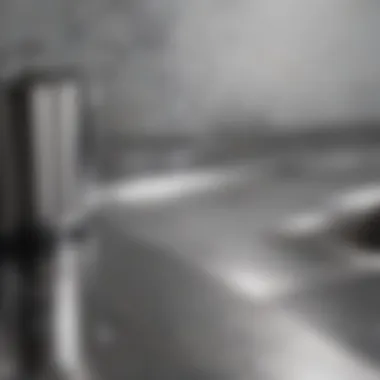Effective Cleaning Methods for Stainless Steel Appliances


Intro
Stainless steel appliances are a staple in many modern kitchens and laundry areas. Their sleek, polished appearance adds a touch of sophistication to any space. However, these surfaces can show fingerprints, streaks, and smudges quite easily, which may detract from their aesthetic appeal. Understanding effective cleaning methods is essential to maintain these appliances.
This article presents a comprehensive guide on cleaning stainless steel appliances, offering insights for homeowners who seek to preserve the beauty and functionality of their investments. Through the examination of various products, techniques, and best practices, readers will discover how to achieve optimal results. The aim is to empower both novice and experienced users with practical cleaning solutions that ensure longevity and shine.
Design Inspiration
Stainless steel not only serves a functional purpose but also accompanies numerous design aesthetics. These appliances can greatly influence the overall look and feel of a kitchen. Their metallic finish coordinates well with various themes.
Trending Styles
In recent years, open-concept kitchens have gained popularity. Stainless steel complements this setup beautifully. Pairing stainless steel with natural wood cabinetry creates a warm yet modern look. On the other hand, a minimalist theme thrives on the sleekness of stainless steel, allowing it to stand out as a statement piece.
Color Palettes
When choosing colors for decor, consider how they interact with stainless steel. Neutral shades like white, gray, and beige work well to emphasize the shine of steel. Accents in dark colors, such as navy blue or forest green, can offer an excellent contrast. This balance preserves a sophisticated ambiance while also inviting warmth into the space.
Practical Tips
Maintaining stainless steel appliances requires attention and care but can be quite straightforward with the right methods.
Maintenance & Care
- Routine Cleaning: Dust and debris can build up on surfaces. Use a soft cloth or microfiber towel to regularly wipe down appliances.
- Commercial Cleaners: Many brands offer specialized stainless steel cleaners. Look for products that are safe for food surfaces.
- Homemade Solutions: A mixture of water and vinegar can work wonders. Spray on the surface, then wipe with a soft cloth to remove stains. A tiny amount of olive oil applied with a cloth can enhance the shine.
- Avoid Harsh Scrubbers: Steel wool or abrasive sponges might scratch the surface, leading to more maintenance issues down the line.
Budgeting & Planning
Keeping stainless steel appliances in top shape does not have to strain your budget. Here are some considerations:
- Invest in Quality: While some commercial cleaners may be pricier, they often provide more effective results, saving time and effort.
- DIY Solutions: Often, common household items like baking soda and vinegar are enough for light cleaning tasks, reducing the need for expensive products.
- Set a Routine: Commit to cleaning your appliances weekly. This helps in categorizing cleaning tasks and controlling the buildup of dirt or grime.
"A little attention to cleaning can prolong the life and appearance of stainless steel appliances."
Overall, understanding the cleaning needs of stainless steel facilitates an environment that is not only aesthetically appealing but also promotes functionality and longevity. By combining commercial products and do-it-yourself methods, homeowners can create a cleaning routine that fits their lifestyle.
Understanding Stainless Steel
Stainless steel is a prevalent choice for countless appliances, offering a blend of functionality and aesthetics. Understanding this material is essential to effectively clean and maintain these surfaces. By grasping the composition, usage, and care needed, homeowners can enhance the durability and appearance of their appliances. Stainless steel not only resists corrosion and staining but also possesses an elegant finish that complements modern interiors. This section breaks down the primary elements that make stainless steel a favored material in the appliance industry.
Composition of Stainless Steel
Stainless steel is an alloy, mainly composed of iron, with a minimum of 10.5% chromium content. This chromium forms a passive layer of chromium oxide on the surface, protecting it from corrosion. Other elements such as nickel, molybdenum, and carbon may also be added to enhance specific properties. For instance, nickel improves ductility and corrosion resistance, while molybdenum increases pitting resistance in chloride environments. Understanding this composition helps in selecting the right cleaning products and methods, which are crucial for maintaining the integrity of the surface over time.
Common Uses in Appliances
The versatility of stainless steel allows for its application in various household appliances. This includes refrigerators, ovens, dishwashers, and sinks. In the kitchen, it is favored for its ability to withstand high temperatures and its easy-to-clean nature. The industrial kitchens also rely on stainless steel for food safety, as it does not harbor bacteria and is highly resistant to rust. Its sleek and modern appearance makes it a sought-after choice for design enthusiasts and homeowners alike, harmonizing with both contemporary and traditional decor.
Why Care is Important
Maintaining stainless steel appliances is crucial for several reasons. First, it preserves the aesthetic appeal, keeping surfaces shiny and free of fingerprints or smudges. Second, with proper care, the lifespan of these appliances can be significantly extended. Regular cleaning removes debris and any corrosive substances that might accumulate, which can lead to surface degradation if left unattended. Without care, even high-quality stainless steel can begin to show signs of wear, reducing its visual and functional value. Therefore, understanding cleaning methods is essential for anyone who invests in stainless steel appliances to ensure they remain in prime condition.
Products for Cleaning Stainless Steel
Cleaning stainless steel appliances effectively requires the right products. Using the appropriate cleaner is essential for maintaining their appearance and ensuring their longevity. An effective cleaner must remove stains and smudges without damaging the surface. Therefore, understanding the different products available is key to achieving optimal results in cleaning.
Commercial Cleaners
Commercial cleaners are popular options for cleaning stainless steel. They are formulated specifically to tackle the challenges posed by stainless steel surfaces.


Types of Commercial Cleaners
When considering commercial cleaners, there are several types that can be beneficial. These cleaners often come in sprays, wipes, or liquid formats. They are designed to dissolve grease, remove fingerprints, and enhance shine. Most products will contain surfactants and solvents to break down stains effectively. The key characteristic of these products is their convenience and effectiveness, making them a preferred choice for busy households. However, one important consideration is that many commercial cleaners can contain strong chemicals that may not be suitable for homes with children or pets.
Safety Considerations
Safety is a major aspect when discussing cleaning products. Many commercial cleaners contain chemicals that can be hazardous if ingested or if they come into contact with skin. It is crucial to read labels carefully and follow safety precautions. Common safety tips include using gloves, ensuring good ventilation, and keeping cleaners out of reach from children. While these cleaner types are effective, their potential hazards require careful usage to prevent any adverse effects or injuries.
Natural Cleaning Solutions
Natural cleaning solutions are increasingly popular for those seeking eco-friendly alternatives. These solutions use common household items and are generally safer for the environment and for human health.
Vinegar
Vinegar stands out as an excellent cleaning agent. Its acidic properties help to cut through grease and dissolve hard water stains. The key characteristic of vinegar is its natural composition, which avoids harsh chemicals. This makes it a beneficial choice for consumers who prioritize sustainability. However, it does have a strong odor that some may find unpleasant, and it is not always as effective on heavy stains compared to commercial products.
Baking Soda
Baking soda is another versatile cleaning solution. It acts as a mild abrasive, providing scrubbing power without scratching the surface. Its key feature is its gentle yet effective cleaning action, which helps with removing tough stains without harming the stainless steel finish. Many people find baking soda to be an economically friendly choice. However, it requires some extra effort as it needs to be mixed with water to create a paste for application.
Microfiber Cloths and Applicators
Microfiber cloths and applicators are essential tools when cleaning stainless steel surfaces. They are designed to effectively lift dirt and oils without leaving scratches. The unique structure of microfiber captures debris more efficiently compared to cotton or paper towels. Using the right applicators ensures that cleaners can work optimally while preserving the integrity of appliances. It is also worth mentioning that microfiber cloths can be washed and reused, making them an eco-friendly option.
Cleaning Techniques
Cleaning techniques are crucial for maintaining the appearance and functionality of stainless steel appliances. Effective cleaning methods not only enhance the visual appeal of these appliances but also extend their lifespan. Proper techniques can prevent scratches and avoid damage associated with improper care. Recognizing the significance of each cleaning step allows homeowners to handle their appliances with the care they deserve.
Pre-Cleaning Steps
Gathering Supplies
Gathering the right supplies is essential to ensure an effective cleaning process. It includes selecting appropriate cleaners, tools, and materials tailored for stainless steel. Having the necessary items on hand allows for a smooth cleaning experience. The key characteristic of this step is organization — knowing what you need before starting is beneficial.
Specific items like microfiber cloths, baking soda, and vinegar are common choices due to their non-abrasive nature. They effectively clean surfaces without causing scratches. However, using certain commercial cleaners can yield better results for tough stains.
Unique features of this aspect include saving time and effort. Preparing an organized cleaning kit helps eliminate distractions while cleaning. Inadequate preparation can lead to frustration and potentially overlook important cleaning steps.
Assessing the Surface Condition
Assessing the surface condition is vital in determining the appropriate cleaning method. Different types of stains or damage require specific approaches. This act helps in identifying whether a surface needs a gentle or a more rigorous cleaning method. A key characteristic here is the condition awareness, ensuring users know what they are tackling.
Observing the surface can reveal indicators such as scratches or accumulated grime that may require special attention. It is beneficial for targeting the correct cleaner or method.
A unique feature of this step is its preventative nature. By understanding the state of the appliance, homeowners avoid using harsh methods that might worsen existing issues. Ignoring surface conditions can lead to further discoloration or deterioration over time.
Step-by-Step Cleaning Process
Applying Cleaner
Applying cleaner is a decisive action in the cleaning process. A suitable cleaner penetrates grime and loosens residues for easier removal. The key characteristic is the effectiveness of the cleaner selected. Proper application ensures that the cleaning solution interacts properly with the surface.
Natural options like vinegar can provide a good balance between safety and efficiency. However, some commercial products are designed specifically for tough marks or stains. The unique feature of this step lies in the even distribution of the cleaner, preventing uneven cleaning or damage.
Scrubbing Techniques
Scrubbing techniques significantly affect the outcome of the cleaning process. How one scrubs determines the removal level of dirt and stains. The key characteristic of this practice is firmness without causing scratches. Proper techniques involve using gentle pressure while adhering to the stainless steel grain.
Microfiber cloths or soft bristle brushes are popular choices. They do not scratch the surface, making them safe for regular use. A unique feature here is the ability to customize the scrubbing based on the stain's severity. Over-scrubbing or using abrasive items can lead to permanent damage.
Wiping and Drying


Wiping and drying are the final steps in achieving a spotless stainless steel surface. This aspect is important as it removes any remaining cleaner and prevents water spots from forming. The key characteristic is the drying technique used, which should leave no residue behind.
Using a clean, dry cloth is essential for this area. A good option is typically a microfiber cloth, known for its absorbency. The unique feature of this practice is that it not only cleans but also polishes the surface, enhancing its shine. Proper drying prevents streaks and water damage.
Avoiding Common Mistakes
Abrasive Materials
Abrasive materials can be tempting due to their apparent cleaning power, but they are often harmful. The impact of using such items can lead to scratches and dull surfaces. The key characteristic here is their destructive potential on stainless steel. Recognizing this issue can save users from costly repairs.
Alternative options, such as microfiber cloths, are far safer, allowing for gentle cleaning. The unique feature of avoiding abrasives is preserving the appliance's finish and ensuring it remains in pristine condition.
Excess Moisture
Excess moisture can be detrimental, leading to water spots or even rust if left unattended. The focus here is on drying techniques after cleaning. The key characteristic of managing moisture is timely action — ensuring surfaces are dried immediately after cleaning.
Utilizing highly-absorbent cloths mitigates this risk. The unique feature is the importance of routine checks to ensure appliances remain clean. Being attentive to moisture can prevent deterioration that could occur over time.
Maintaining Stainless Steel Appliances
Maintaining stainless steel appliances is crucial for both aesthetics and longevity. The shiny surfaces of these appliances can quickly become dull and marred if not cared for properly. Regular attention not only enhances their visual appeal but also prolongs their lifespan, ensuring that they serve their purpose effectively.
Stainless steel is known for its durability, but it is prone to scratches, fingerprints, and staining from food and cleaning products. Thus, a consistent maintenance routine is essential. Not only does it preserve the sleek appearance, but it also minimizes the risk of extensive damage that might arise due to neglect.
Elements like moisture and harsh cleaning methods can worsen the condition of the surface. Therefore, employing a thoughtful approach to maintenance can save homeowners from costly repairs or replacements in the future.
Regular Maintenance Schedule
Having a regular maintenance schedule ensures that stainless steel appliances remain in optimal condition. Scheduling maintenance tasks weekly or monthly can simplify the cleaning process and help identify potential issues before they escalate.
- Weekly Cleaning: Wipe down surfaces with a damp microfiber cloth to remove dust and light stains.
- Monthly Deep Cleaning: Apply a suitable cleaner to eliminate tougher stains and restore shine.
- Seasonal Inspection: Analyze for scratches or discolored areas to address them early on.
A systematic routine boosts the likelihood of maintaining the appliances' original allure. Regular cleaning also requires less time than an occasional deep clean, making it a more efficient method.
Long-Term Protective Measures
Innovative protective measures can significantly enhance the durability of stainless steel appliances. These methods are not just for immediate aesthetics; they play a pivotal role in long-term maintenance as well.
Using Protective Coating
Using a protective coating offers a substantial barrier against potential damage. It aids in preventing stains and fingerprints, making the surface easier to clean. Many of these coatings are hydrophobic, which means they repel water and thus, reduce water spots.
A key characteristic of protective coatings is that they provide a sheer shield without altering the surface appearance. This is advantageous for homeowners who wish to maintain the original look while enhancing protection.
However, while protective coatings are popular, they also require reapplication every few months. The benefits generally outweigh the minor inconvenience of upkeep.
Seasonal Deep Cleaning
Seasonal deep cleanings serve as the ultimate reset for stainless steel appliances. This approach goes beyond regular maintenance by addressing built-up grime that may accumulate over time. It allows for a thorough inspection, ensuring all areas are cleaned and maintained.
A hallmark of seasonal deep cleaning is its comprehensive nature. It targets inaccessible spots that regular cleaning might miss, promoting overall hygiene and appearance.
The unique feature of this method is that, unlike regular cleaning, it reinforces the appliance's resistance to stains and wear by rejuvenating the surface. Seasonal deep cleaning can prevent more significant issues and extend the life of appliances, making it beneficial for any homeowner.
Dealing with Stains and Discoloration
Stains and discoloration on stainless steel appliances are not just unsightly; they can affect the overall perception of cleanliness and maintenance in a home. Addressing these issues is paramount for both aesthetic appeal and the longevity of the appliances. This section delves into common types of stains and effective techniques to tackle them, offering readers strategies to keep their appliances looking polished.
Identifying Common Stains


Understanding the most common stains can aid homeowners in their cleaning efforts. This knowledge enables better preparation and more effective cleaning solutions.
Water Spots
Water spots are often one of the most prevalent issues faced when maintaining stainless steel appliances. These spots arise when water droplets are left to dry on the surface, leaving mineral deposits behind. The key characteristic of water spots is that they are typically circular and can appear hazy.
Water spots are included in this article because they are particularly bothersome in kitchens and bathrooms, where cleanliness is crucial. The unique feature of water spots is their ability to form even after careful cleaning, especially in areas with hard water.
The main advantage of addressing water spots promptly is that it can prevent more severe corrosion or mineral buildup. However, if neglected, these spots can become difficult to remove, requiring stronger cleaning solutions which may not be recommended for all stainless steel finishes.
Fingerprint Marks
Fingerprint marks represent another common issue, especially on appliances that receive regular handling like ovens and refrigerators. The key characteristic of fingerprint marks is their oily appearance, which draws attention to the area and can create an overall impression of neglect.
They are vital to mention in this article since they frequently detract from the sleek look of stainless steel. Fingerprint marks tend to appear more prominently on brushed stainless steel surfaces, where their visibility can be quite strong.
One unique feature of these marks is that they can vary in intensity, depending on the cleanliness of the hands that touched the surface. The advantage of knowing how to effectively deal with fingerprint marks is that it aids homeowners in maintaining the pristine look of their appliances. On the downside, frequent cleaning of these marks can lead to surface wear if inappropriate cleaning tools or chemicals are used.
Specialized Cleaning Techniques for Stains
To navigate the issues presented by stains, specialized cleaning techniques are necessary. Each stain type may require a different approach to avoid damaging the finish while effectively removing the mark.
- For Water Spots:
- For Fingerprint Marks:
- Use distilled water and a microfiber cloth. This method can help avoid the formation of new spots.
- If spots persist, a 1:1 mixture of vinegar and water can gently dissolve the mineral deposits.
- Apply a gentle cleaner specifically meant for stainless steel surfaces. Follow up by buffing with a dry microfiber cloth to restore shine.
- Using a non-abrasive polish can also help, creating a protective barrier that minimizes future fingerprints.
Keeping appliances free of stains improves their aesthetic appeal and preserves their structural integrity.
Using these methods not only enhances the visual aspect but also assists in maintaining the overall quality of stainless steel appliances. This proactive approach ensures long-term satisfaction and efficiency in daily use.
Environmental Considerations
Understanding the environmental implications of cleaning stainless steel appliances is crucial. As awareness of ecological issues grows, homeowners increasingly seek solutions that reduce their carbon footprint. Effective cleaning methods shouldn't only benefit the surfaces being cleaned but also consider the impact on the environment. Focusing on sustainable practices can enhance both the functionality and beauty of your appliances while being kind to the planet.
Sustainability of Cleaning Products
Sustainability in cleaning products means selecting those that cause minimal harm to the environment. Many commercial cleaners contain chemicals that contribute to pollution and can pose health risks. When choosing cleaning solutions, a few key aspects must be considered:
- Ingredients: Look for products with biodegradable substances. This ensures that, once washed off, they will not linger in the environment.
- Packaging: Opt for items with recyclable or minimal packaging. This small change can significantly reduce waste.
- Certifications: Seek products certified by recognized organizations dedicated to sustainable practices. These certifications provide assurance about the product's environmental claims.
Using sustainable products not only protects the environment but can also improve indoor air quality.
Disposing of Chemicals Responsibly
Disposing of cleaning chemicals properly is as important as choosing the right ones. Improper disposal can lead to detrimental effects on soil and water sources. Homeowners should take the following steps:
- Read Labels: Many cleaning products include disposal instructions. Following these guidelines ensures compliance with local regulations.
- Hazardous Waste Centers: For chemicals not safe for regular trash, utilize local hazardous waste facilities. This prevents harmful substances from contaminating landfills.
- Community Programs: Check if local municipalities have events or programs focused on the safe disposal of cleaning agents. Engaging in these initiatives can promote environmental health.
Proper disposal practices can significantly minimize pollution and protect our ecosystems from harmful substances.
Integrating these environmental considerations into your cleaning routine can lead to a healthier home and a more sustainable future.
Closure
Cleaning stainless steel appliances is essential for maintaining their appearance and functionality. This article details various effective cleaning methods that enhance the aesthetic and prolong the life of such appliances.
Summary of Key Points
Throughout the article, we identified several crucial elements related to cleaning stainless steel:
- Understanding Stainless Steel: Recognizing its unique composition and common uses helps emphasize the importance of appropriate care.
- Products Available: From commercial cleaners to natural solutions, each type offers unique benefits and suitability for different cleaning needs.
- Techniques: Using proper techniques ensures effective cleaning without causing damage. Avoiding common mistakes like using abrasive materials is vital.
- Maintenance: Establishing a regular maintenance schedule and understanding long-term protection can prevent more severe issues.
- Stain Management: Knowing how to deal with common stains enhances overall cleanliness and appearance.
- Environmental Considerations: Using sustainable products and disposing of chemical waste responsibly reflects a commitment to both appliance care and environmental health.
"Regular cleaning not only restores shine but also reduces wear and tear on stainless steel surfaces."
Final Thoughts on Cleaning Practices
The approach to cleaning stainless steel is multifaceted. Homeowners should align their methods with the type of surface and the specific challenges encountered. Emphasizing both commercial and DIY solutions provides a balanced view of cleaning strategies. With proper care and maintenance, the longevity and aesthetic appeal of stainless steel appliances will greatly increase, making them a valuable asset in any home.
In summary, by adopting a comprehensive cleaning regime, homeowners can not only enjoy their stainless steel appliances looking their best but also ensure their functionality for years to come.















